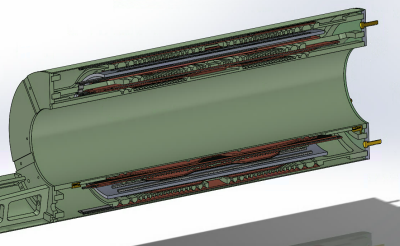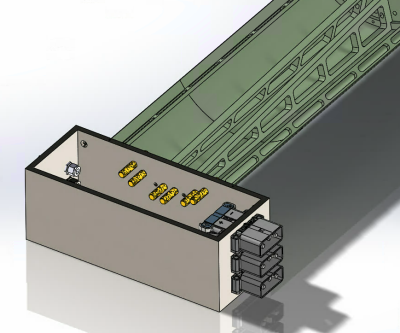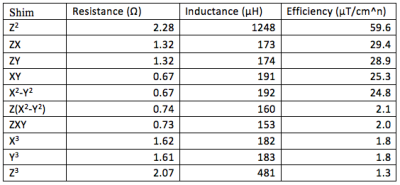4421
Development of a Gradient and Shim Insert System for Marmoset Imaging at 9.4 T1The xMR Labs, Department of Physics & Astronomy, Western University, London, ON, Canada, 2Centre for Functional and Metabolic Mapping, Robarts Research Institute, London, ON, Canada, 3Medical Biophysics, Western University, London, ON, Canada
Synopsis
A replacement gradient coil for a 9.4 T preclinical system (31-cm inner diameter magnet) has been designed and is currently under construction. The new gradient and shim system will allow for improved imaging performance on the 9.4 T system, and has been developed specifically for marmoset imaging studies. Efficiencies of 1.5 mT/m/A for an ROI of size 8.5 cm at 5% homogeneity were achieved. A 10-channel shim set (not including first-order gradient shims) is included, with minimized inductive coupling to the gradient axes.
Introduction
Ultra-high field MRI allows visualization of neural white matter, which is known to be altered in disorders such as multiple sclerosis, Alzheimer’s, and schizophrenia(1). The marmoset model has been described as the bridge between mouse and man because of its genetic, immunological, and microbiological similarities to a human(2). Protocols for isolating major white matter fiber tracts in the marmoset model using ultra-high field MRI diffusion-weighted imaging have been proposed(3). In order to visualize these tracts with high spatial resolution, a high-performance gradient system is needed.Methods
The gradients were designed to be force and torque balanced within the known magnetic field of the 9.4 T system using a boundary element method (BEM) that minimized the power deposited in the bore surfaces of the superconducting system, so as to minimize the interactions of the gradient with the magnet system and to reduce the possibility of quench and eddy currents in conducting structures. Given the complex parameter space, solutions were chosen that gave an optimal wire separation to minimize resistance, achieve the target efficiency of 1.5 mT/m/A, homogeneity of 5% within an 8 cm volume, and were buildable given current fabrication methods(4–9). All three gradient axes were designed using three surfaces rather than the usual two (with the primary split between two layers, and then an outer single shielding layer), which allowed design parameters to be achieved with an acceptable inductance.
The shims were designed using a variant BEM approach that allowed the mutual inductance with the gradients to be minimized while still achieving the field goals for each spherical harmonic shim. All second-order shims (i.e. 5), but only a select group of third order shims, were included in the design due to radial space limitations.
The z-axis was constructed using hollow square wire, employing interior water cooling, on G10-FR4 formers. The x- and y-axes were water-jet cut from a solid sheet of copper and rolled to the correct radii. The shims were cut from copper-clad G10-FR4 sheets and wrapped around formers to achieve the correct radii.
Results
The coil has been designed according to the specifications in Table 1 and Table 2, and is currently in the manufacturing process. Figure 1 shows the construction process of the second layer of the coil, while Figures 2 and 3 show the planned design construction in a 3D model.Discussion
An effective gradient is under development for ultra-high field imaging of marmosets, as well as other small animal models of equivalent or smaller size. Once complete, it will assist in determining the link between neural white matter alterations and disorders such as multiple sclerosis, Alzheimer’s, and schizophrenia.Acknowledgements
We acknowledge the members of the xMR Labs at Western University for their contributions to this project as well as funding from: the NSERC Industrial Research Chairs Program, the Ontario Research Fund, the Canadian Foundation for Innovation, the Canada Brain Research Fund, and BrainsCAN (CFREF).References
1. Okano H, Mitra P. Brain-mapping projects using the common marmoset. Neurosci. Res. [Internet] 2015;93:3–7. doi: 10.1016/j.neures.2014.08.014.
2. ‘t Hart BA, van Kooyk Y, Geurts JJG, Gran B. The primate autoimmune encephalomyelitis model; a bridge between mouse and man. Ann. Clin. Transl. Neurol. [Internet] 2015;2:581–593. doi: 10.1002/acn3.194.
3. Schaeffer DJ, Adam R, Gilbert KM, Gati JS, Li AX, Menon RS, Everling S. Diffusion weighted tractography in the common marmoset monkey at 9.4 T. 2017. doi: 10.1152/jn.00259.2017.
4. Lemdiasov RA, Ludwig R. A stream function method for gradient coil design. Concepts Magn. Reson. Part B Magn. Reson. Eng. 2005;26:67–80. doi: 10.1002/cmr.b.20040.
5. Peeren GN. Stream function approach for determining optimal surface currents. J. Comput. Phys. 2003;191:305–321. doi: 10.1016/S0021-9991(03)00320-6.
6. Pissanetzky S. Minimum energy MRI gradient coils of general geometry. Meas. Sci. Technol. 1992;667:667–673.
7. Poole M, Bowtell R. Novel Gradient Coils Designed Using a Boundary Element Method. Concepts Magn. Reson. Part B Magn. Reson. Eng. 2007;35:162–175. doi: 10.1002/cmr.b.20091.
8. Handler WB, Harris CT, Scholl TJ, Parker DL, Goodrich KC, Dalrymple B, Van Sass F, Chronik BA. New head gradient coil design and construction techniques. J. Magn. Reson. Imaging 2014;39:1088–1095. doi: 10.1002/jmri.24254.
9. Harris CT, Handler WB, Chronik BA. Electromagnet Design Allowing Explicit and Simultaneous Control of Minimum Wire Spacing and Field Uniformity. Concepts Magn. Reson. Part B Magn. Reson. Eng. 2012;41B:120–129. doi: 10.1002/cmr.b.
Figures




